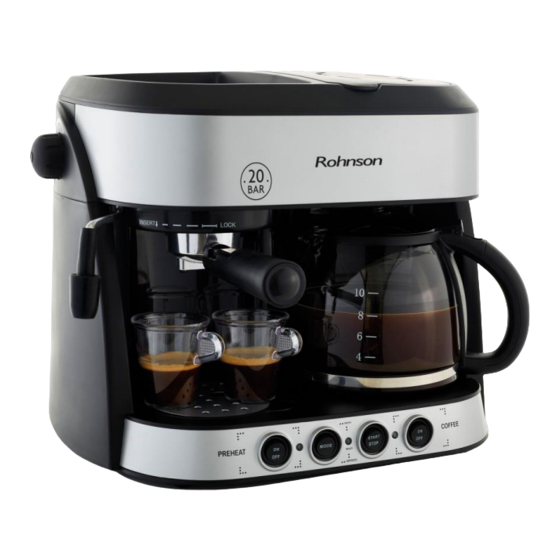
Subscribe to Our Youtube Channel
Summary of Contents for Rohnson R-974
- Page 1 COFFEE MAKER INSTRUCTION MANUAL MODEL: R-974 Please read this manual carefully before using and save it for future reference...
-
Page 2: Important Safeguards
IMPORTANT SAFEGUARDS Before using the electrical appliance, the following basic precautions should always be followed including the following: 1. Read all instructions. 2. Before using check that the voltage of wall outlet corresponds to rated voltage marked on the rating plate. 3. - Page 3 reduced physical, sensory or mental capabilities or lack of experience and knowledge if they have been given supervision or instruction concerning use of the appliance in a safe way and understand the hazards involved. Children shall not play with the appliance. Cleaning and user maintenance shall not be made by children without supervision.
-
Page 4: Know Your Product
KNOW YOUR PRODUCT... -
Page 5: Before The First Use
OPERATIONAL USE OF THE PANEL ESPRESSO COFFEE ( switch I) Push the button for espresso preparation, Indicator 1 will come on. When the indicator 2 comes on, push the MODE Switch to “espresso” position and push the start/stop switch to “start”... - Page 6 3. Set steel mesh into metal funnel (no coffee in steel mesh). 4. Place carafe on keeping warm plate and put small carafe on removable shelf. 5. Plug the power cord into the outlet. Press the switchⅡ for drip coffee, the indicator 3 will be illuminated.
- Page 7 PRE-HEATING To make a cup of good hot espresso coffee, we recommend you preheat the appliance before making coffee, including the funnel, filter and cup, so that the coffee flavour can not be influenced by the cold parts. 1. Open the top cover and fill the tank with desired water according to the gauge. Replace the top cover.
- Page 8 SWITCH to “stop” position to stop make espresso coffee. After a few seconds, if indicator 2 is illuminated again, you can make espresso coffee continued by turning “START/STOP SWITCH to “start” position, the indicator 2 is cycle on and off to maintain the water temperature is hot enough.
- Page 9 5. Insert the frothing device into the milk about two-centimetre, froth milk in the way moving vessel round from up to down. 6. When the required purpose is reached, you can turn the steam controller to off position to stop generating the steam. Note: Clean frothing device with wet sponge immediately after steam stops generating but care not to hurt! 7.
-
Page 10: Clean And Maintenance
AUTOMATIC POWER OFF FUNCTION FOR ESPRESSO 1. After pressing switchⅠ, if there is not any operation within 25 minutes, the unit will power off automatically. switchⅠ, turn START/STOP switch to ‘start’ position, after pump 2. After pressing worked for 3 minutes, the unit will power off automatically. switchⅠ, turn MODE switch to “Froth”... - Page 11 5. When the indicator 2 is illuminated, it shows the heating is finish. Press MODE switch to “Espresso” position and turn START/STOP switch to “start” position to make two cups coffee (about 2Oz). Then turn START/STOP switch to “stop” position. 6.
-
Page 12: Troubleshooting
TROUBLE SHOOTING Symptom Cause Corrections Let centreline of carafe aligns with carafe located leakage opening of brew basket Carafe leakage water or water properly leaks out from lid of carafe well. The level of water in the tank The water level in the tank should be exceeds the scale of MAX. - Page 13 IMPORTANT INFORMATION FOR CORRECT DISPOSAL OF THE PRODUCT IN ACCORDANCE WITH EC DIRECTIVE 2002/96/EC. At the end of its working life, the product must not be disposed of as urban waste. It must be taken to a special local authority differentiated waste collection centre or to a dealer providing this service.














Need help?
Do you have a question about the R-974 and is the answer not in the manual?
Questions and answers